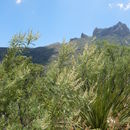Comprehensive Description
provided by North American Flora
Eysenhardtia texana Scheele, Linnaea 21: 462. 1848
A much branched shrub, 2.5-3.5 m. high; stems gray, the young growth more or less canescent with appressed white hairs; leaves 3-6 cm. long, spreading; stipules 2-3 mm. long, brownish, subulate; stipels subulate, less than 0.5 mm. long, shorter than the petiolules, more or less persistent; leaflets 15-31, oblong, 5-11 mm. long, dull-green above, slightly paler beneath, more or less puberulent above and beneath, punctate beneath with minute dark dots, obscurely reticulate above, firm; racemes 3-11 cm. long; bracts 1-2 mm. long, ovate-lanceolate, brown, pubescent, more or less persistent until anthesis; calyx-tube 2-2.2 mm. long, glandular-dotted, more or less canescent-puberulent, slightly ridged, split much more deeply (but not to the middle) on the posterior side; lobes 0.6-0.9 mm. long, obtusish to acute, finely pubescent; petals 4-5 mm. long, membranous, more than twice as long as the calyx, the standard slightly broader, rounded to slightly emarginate; style 2.5-3 mm. long, pubescent, slightly upcurved at the apex, the gland at the curve short and thick, conspicuous, reddish-brown; pods 7-10 mm. long, 1.7— 2.5 mm. wide, thickened, greenish-brown, glabrous, punctate distally with evident glands, more or less strongly upcurved throughout, at maturity ascending, on pedicels 0.5-1 mm. long; seed 3.2-3.7 mm. long, lanceolate to obovoid, thickened, very smooth, brown, with a broad basal lobe, filling three fifths to two thirds the length of the pod.
Type locality: New Braunfels, Texas.
Distribution: Dry hillsides and canons, southern Texas to Coahuila and Tamaulipas.
- bibliographic citation
- Per Axel Rydberg. 1919. (ROSALES); FABACEAE; PSORALEAE. North American flora. vol 24(1). New York Botanical Garden, New York, NY
Comprehensive Description
provided by North American Flora
Eysenhardtia angustifolia Pennell, sp. nov
A much branched small tree, 3-4 m. high ; stems grayish-brown, the young growth canescent with whitish incurved to appressed hairs; leaves 8-9 cm. long, spreading; stipules 3-4 mm. long, grayish, filiform; stipels subulate, less than 0.5 mm. long, shorter than the petiolules, deciduous; leaflets 37-47, narrowly oblong, 10-12 mm. long, dull-green above, slightly paler beneath, puberulent above and beneath, punctate beneath with small nearly black dots, reticulate above, firm; racemes 4-7 cm. long; bracts 1-2 mm. long, ovate-acuminate, brown, pubescent, more or less persistent through anthesis; calyx-tube 2.3-3 mm. long, glandular-dotted, finely canescent, ridged, split slightly more deeply on the posterior side; lobes 0.6-0.8 mm. long, obtusish, pubescent; petals 4-4.5 mm. long, membranous, from less than twice to twice as long as the calyx, the standard broader, broadly emarginate; style 2.5-3 mm. long, pubescent, slightly upcurved at the apex, the gland at the curve large, conspicuous, paleyellowish; pods 7-8 mm. long, 2-2.2 mm. wide, slightly thickened, greenish-brown, glabrous, punctate distally with relatively large glands, slightly upcurved at the apex, at maturity ascending on pedicels 0.5-0.6 mm. long; seed 3.3 mm. long, lanceolate, thickened, very smooth, olive-brown, with a broad basal lobe, filling one half to three fifths the length of the pod.
Type collected in flower and fruit, at Sanderson [Terrill County], Texas, September 29, 1911, E. O. Wooion (U. S. Nat. Herb.).
Distribution: Trans-Pecos region of Texas.
- bibliographic citation
- Per Axel Rydberg. 1919. (ROSALES); FABACEAE; PSORALEAE. North American flora. vol 24(1). New York Botanical Garden, New York, NY

